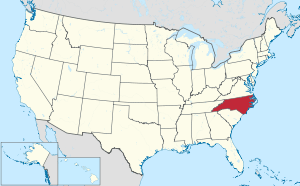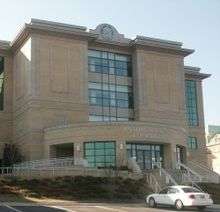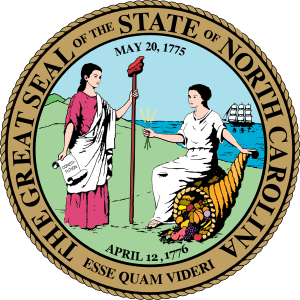Randolph County, North Carolina
Randolph County is a county located in the U.S. state of North Carolina. As of the 2010 census, the population was 141,752.[1] Its county seat is Asheboro.[2]
Randolph County | |
|---|---|
 Randolph County Courthouse and Confederate statue | |
 Seal | |
 Location within the U.S. state of North Carolina | |
 North Carolina's location within the U.S. | |
| Coordinates: 35°43′N 79°49′W | |
| Country | |
| State | |
| Founded | 1779 |
| Named for | Peyton Randolph |
| Seat | Asheboro |
| Largest city | Asheboro |
| Area | |
| • Total | 789 sq mi (2,040 km2) |
| • Land | 783 sq mi (2,030 km2) |
| • Water | 6.8 sq mi (18 km2) 0.9%% |
| Population | |
| • Estimate (2019) | 143,667 |
| • Density | 181/sq mi (70/km2) |
| Time zone | UTC−5 (Eastern) |
| • Summer (DST) | UTC−4 (EDT) |
| Congressional district | 6th |
| Website | www |

Randolph County is included in the Greensboro-High Point, NC Metropolitan Statistical Area, which is also included in the Greensboro-Winston-Salem-High Point, NC Combined Statistical Area.
In 2010, the center of population of North Carolina was located in Randolph County, near the town of Seagrove.[3]
History
Some of the first settlers of what would become the county were English Quakers, who settled along the Haw, Deep, and Eno Rivers.[4] The county was formed in 1779 from Guilford County. It was named for Peyton Randolph, first president of the Continental Congress.
County formation
The Legislature of 1779, then sitting at Halifax, passed an act providing for the formation of a new county out of Guilford and Rowan, to be called Randolph. Notice having been given, the citizens met accordingly on Monday, the 8th day of March, 1779. Proclamation being made, the act of Assembly was read, wherein, William Cole, John Collin, Joseph Hinds, George Cortner, John Arnold, William Millikan, John Hinds, Jacob Shepherd, Richardson Owen, Windsor Pearce, William Bell, William Merrill, John Lowe, Enoch Davis, and James Hunter were nominated Justices for holding the courts in said county. The oath of allegiance and the oath of office was administered by William Cole, Esq., whereupon they took their seats and organized and held the first court in Randolph county by electing William Bell, Sheriff, William Millikan, Register of Deeds, and Absalom Tatum', Clerk.[5]
Randolph County was the original location of what became Duke University.
The county is home to one of the last remaining covered bridges in the state. The Pisgah Covered Bridge, in Union Township, in the southwestern part of the county, was destroyed by a flood in 2003, but has been rebuilt.[6][7]
In 1911, a new county called Piedmont County was proposed, with High Point as its county seat, to be created from Guilford, Davidson, and Randolph Counties. Many people appeared at the Guilford County courthouse to oppose the plan, vowing to go to the state legislature to protest. The state legislature voted down the plan in February 1911.[8][9]
Geography
According to the U.S. Census Bureau, the county has a total area of 789 square miles (2,040 km2), of which 783 square miles (2,030 km2) is land and 6.8 square miles (18 km2) (0.9%) is covered by water.[10]
Randolph County is located in the center of North Carolina, and the city of Asheboro (in the county) is the center point of North Carolina. Randolph County is located in the Piedmont section of central North Carolina, a region of gently rolling hills and woodlands. However, the central and western parts of the county contain the Uwharrie Mountains and the Caraway Mountains. These two ranges are the remnants of a much-higher range of ancient peaks. Today, they rarely top 1,000 feet (300 m) above sea level, yet due to the relative low terrain around them, they still rise 200–500 feet (61–152 m) above their base. The highest point in Randolph County is Shepherd Mountain, a peak in the Caraways. The North Carolina Zoo is located atop Purgatory Mountain, one of the peaks of the Uwharries.
Adjacent counties
- Guilford County - north
- Alamance County - northeast
- Chatham County - east
- Moore County - southeast
- Montgomery County - southwest
- Davidson County - west
Demographics
| Historical population | |||
|---|---|---|---|
| Census | Pop. | %± | |
| 1790 | 7,318 | — | |
| 1800 | 9,234 | 26.2% | |
| 1810 | 10,112 | 9.5% | |
| 1820 | 11,331 | 12.1% | |
| 1830 | 12,406 | 9.5% | |
| 1840 | 12,875 | 3.8% | |
| 1850 | 15,832 | 23.0% | |
| 1860 | 16,793 | 6.1% | |
| 1870 | 17,551 | 4.5% | |
| 1880 | 20,836 | 18.7% | |
| 1890 | 25,195 | 20.9% | |
| 1900 | 28,232 | 12.1% | |
| 1910 | 29,491 | 4.5% | |
| 1920 | 30,856 | 4.6% | |
| 1930 | 36,259 | 17.5% | |
| 1940 | 44,554 | 22.9% | |
| 1950 | 50,804 | 14.0% | |
| 1960 | 61,497 | 21.0% | |
| 1970 | 76,358 | 24.2% | |
| 1980 | 91,728 | 20.1% | |
| 1990 | 106,546 | 16.2% | |
| 2000 | 130,454 | 22.4% | |
| 2010 | 141,752 | 8.7% | |
| Est. 2019 | 143,667 | [11] | 1.4% |
| U.S. Decennial Census[12] 1790-1960[13] 1900-1990[14] 1990-2000[15] 2010-2019[1] | |||
As of the census[16] of 2000, 130,454 people, 50,659 households, and 37,335 families resided in the county. The population density was 166 people per square mile (64/km²). The 54,422 housing units averaged 69 per square mile (27/km²). The racial makeup of the county was 89.20% White, 5.63% Black or African American, 0.45% Native American, 0.64% Asian, 0.02% Pacific Islander, 3.01% from other races, and 1.06% from two or more races. About 6.63% of the population was Hispanic or Latino of any race.
As with much of North Carolina, the Latino population of Randolph County continued to grow into the 21st century. In 2005, figures placed the Latino population as 9.3% of the county’s total.
In 2000, of the 50,659 households, 33.70% had children under the age of 18 living with them, 59.10% were married couples living together, 10.20% had a female householder with no husband present, and 26.30% were not families. About 22.50% of all households were made up of individuals, and 8.60% had someone living alone who was 65 years of age or older. The average household size was 2.55 and the average family size was 2.97.
In the county, the population was distributed as 25.00% under the age of 18, 8.00% from 18 to 24, 31.30% from 25 to 44, 23.50% from 45 to 64, and 12.10% who were 65 years of age or older. The median age was 36 years. For every 100 females, there were 97.80 males. For every 100 females age 18 and over, there were 95.40 males.
The median income for a household in the county was $38,348, and for a family was $44,369. Males had a median income of $30,575 versus $22,503 for females. The per capita income for the county was $18,236. About 6.80% of families and 9.10% of the population were below the poverty line, including 11.60% of those under age 18 and 11.50% of those age 65 or over.
Communities
Cities
- Archdale (part)
- Asheboro (county seat)
- High Point (part)
- Randleman
- Thomasville (part)
- Trinity
Townships
- Asheboro
- Archdale
- Back Creek
- Brower
- Cedar Grove
- Coleridge
- Columbia
- Concord
- Farmer
- Franklinville
- Grant
- Level Cross
- Liberty
- New Hope
- New Market
- Pleasant Grove
- Providence
- Randleman
- Richland
- Tabernacle
- Trinity
- Union
Unincorporated communities
Politics, law and government
Randolph County is a member of the regional Piedmont Triad Council of Governments.
The county was one of the earliest in North Carolina and the South to turn Republican, and is often considered one of the most Republican-dominated counties in the state. It has supported the Republican presidential candidate in all but three elections since 1916. No Democratic presidential nominee has carried the county since Franklin D. Roosevelt in 1940, and Jimmy Carter is the last Democrat to even tally 40 percent of the county's vote. In 1964, it was the easternmost county in the state to vote for Barry Goldwater. Republican dominance at the local level is so absolute that in some cases, Republican candidates and incumbents run unopposed.
| Year | Republican | Democratic | Third parties |
|---|---|---|---|
| 2016 | 76.6% 49,430 | 20.4% 13,194 | 3.0% 1,951 |
| 2012 | 74.4% 45,160 | 24.3% 14,773 | 1.3% 782 |
| 2008 | 70.5% 40,998 | 28.2% 16,414 | 1.3% 735 |
| 2004 | 74.2% 37,771 | 25.5% 12,966 | 0.3% 173 |
| 2000 | 72.5% 30,959 | 26.6% 11,366 | 0.9% 371 |
| 1996 | 61.4% 23,030 | 28.7% 10,783 | 9.9% 3,722 |
| 1992 | 53.2% 20,697 | 29.0% 11,274 | 17.8% 6,931 |
| 1988 | 73.3% 23,881 | 26.5% 8,641 | 0.2% 49 |
| 1984 | 77.4% 25,759 | 22.6% 7,511 | 0.1% 29 |
| 1980 | 64.7% 19,881 | 32.9% 10,107 | 2.4% 729 |
| 1976 | 52.7% 14,337 | 46.8% 12,714 | 0.5% 146 |
| 1972 | 76.0% 18,724 | 21.7% 5,346 | 2.3% 559 |
| 1968 | 52.4% 13,450 | 20.8% 5,351 | 26.8% 6,892 |
| 1964 | 56.4% 13,739 | 43.6% 10,638 | |
| 1960 | 61.7% 15,772 | 38.3% 9,789 | |
| 1956 | 61.1% 13,174 | 39.0% 8,404 | |
| 1952 | 58.1% 12,429 | 41.9% 8,975 | |
| 1948 | 53.4% 8,372 | 41.9% 6,567 | 4.7% 743 |
| 1944 | 54.7% 8,768 | 45.4% 7,277 | |
| 1940 | 45.5% 7,056 | 54.5% 8,455 | |
| 1936 | 46.1% 6,927 | 53.9% 8,090 | |
| 1932 | 45.0% 6,072 | 54.4% 7,345 | 0.6% 75 |
| 1928 | 63.9% 7,414 | 36.1% 4,188 | |
| 1924 | 53.9% 6,336 | 45.9% 5,397 | 0.2% 24 |
| 1920 | 55.2% 6,297 | 44.8% 5,110 | |
| 1916 | 52.4% 3,031 | 47.5% 2,747 | 0.1% 3 |
| 1912 | 7.6% 370 | 55.0% 2,665 | 37.4% 1,815 |
Education
- Randolph County School System serves most of the county. Asheboro City Schools serves Asheboro.
- Fayetteville Street Christian School, located in Asheboro, is the largest private school in Randolph County.[18]
Notable people
- Adam Petty - NASCAR driver. Son of Kyle Petty. Killed in New Hampshire.
- Braxton Craven - educator and second president of Trinity College, which later moved to Durham and became Duke University.
- Corey Hunt - Songwriter
- Gideon Morris - trans-Appalachian pioneer and founder of Morristown, Tennessee
- Heaven Fitch - wrestler
- Heidi N. Closet - African-American drag queen & contestant of RuPaul's Drag Race, season 12.
- Jerry Bledsoe - author
- Jonathan Worth - North Carolina Governor
- Kyle Petty - NASCAR driver. Son of Richard Petty
- Lee Petty - NASCAR pioneer. Father of Richard Petty
- Rufus Hussey - The Beanshooter Man who appeared on The Tonight Show Starring Johnny Carson.[19]
- Richard Petty - NASCAR driver. Son of Lee Petty.
- Sam Ard - NASCAR driver
- Naomi Wise - murder victim
See also
References
- "State & County QuickFacts". United States Census Bureau. Retrieved October 29, 2013.
- "Find a County". National Association of Counties. Retrieved 2011-06-07.
- "Centers of Population by State: 2010". United States Census Bureau. Retrieved April 13, 2014.
- Bishir, Catherine (2005). North Carolina Architecture. UNC Press. p. 38.
- Reminiscences of Randolph County, author: J.A.Blair 1890
- Mark Brumley and Cynthia Jeffries, "Rain Washes Away Historical Bridge," Greensboro News & Record, August 11, 2003.
- "You don't have to go far for local history," Greensboro News & Record, June 19, 2010.
- Jack Scism, "Remember When?", Greensboro News & Record, January 23, 2011.
- Jack Scism, "Remember When?", Greensboro News & Record, February 6, 2011.
- "2010 Census Gazetteer Files". United States Census Bureau. August 22, 2012. Archived from the original on January 12, 2015. Retrieved January 19, 2015.
- "Population and Housing Unit Estimates". Retrieved May 21, 2020.
- "U.S. Decennial Census". United States Census Bureau. Retrieved January 19, 2015.
- "Historical Census Browser". University of Virginia Library. Retrieved January 19, 2015.
- Forstall, Richard L., ed. (March 27, 1995). "Population of Counties by Decennial Census: 1900 to 1990". United States Census Bureau. Retrieved January 19, 2015.
- "Census 2000 PHC-T-4. Ranking Tables for Counties: 1990 and 2000" (PDF). United States Census Bureau. April 2, 2001. Retrieved January 19, 2015.
- "U.S. Census website". United States Census Bureau. Retrieved 2008-01-31.
- Leip, David. "Dave Leip's Atlas of U.S. Presidential Elections". uselectionatlas.org.
- "Fayetteville Street Christian School". www.fscspatriots.org. Retrieved 2018-03-17.
- "Rufus Hussey... The Beanshooter Man". www.asheboro.com.
External links
| Wikimedia Commons has media related to Randolph County, North Carolina. |
- Official website
- NCGenWeb Randolph County - free genealogy resources for the county
- Official Visitor Information
- North Carolina Architects & Builders

